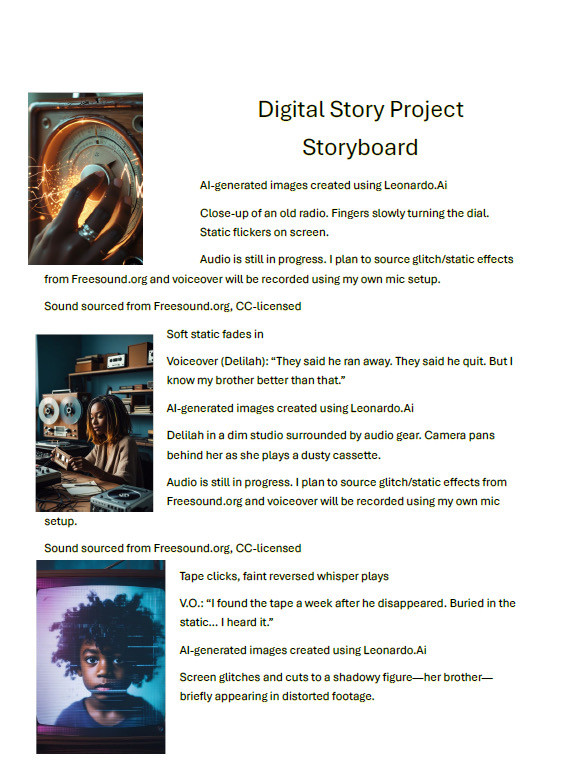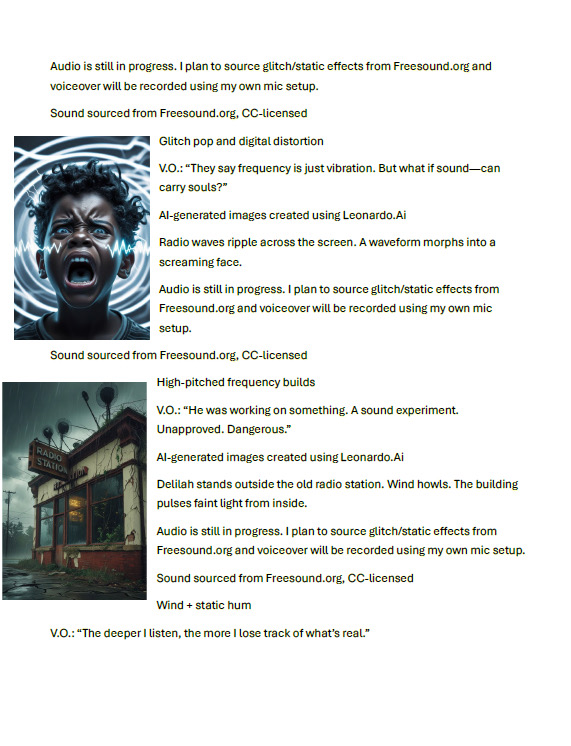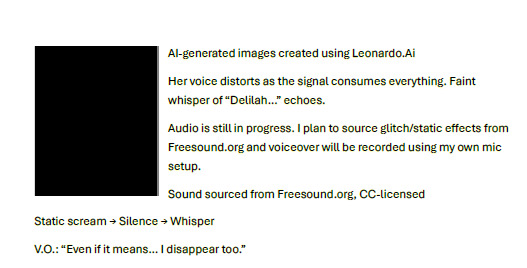Synopsis
After her brother mysteriously vanishes, Delilah Clarke, a young sound engineer, discovers a hidden frequency that allows her to hear voices from the other side. As she deciphers the messages, she realizes her brother is trapped in an alternate dimension—one created by an experiment gone wrong at the radio station where he worked. With time running out, Delilah must use her unique ability to uncover the truth behind the Ghost Frequency before it consumes her too. Script
Script
(STATIC BUZZ. GLITCHED WHISPER. THEN… SILENCE)
DELILAH (V.O.):
They said he ran away.
They said he quit.
But I know my brother better than that.
(LOW, DISTORTED FREQUENCY UNDER VOICE. SHOT OF A RADIO DIAL TURNING.)
I found the tape a week after he disappeared.
Buried in the static… I heard it.
(DISTORTED WHISPER: “Help me.”)
They say frequency is just vibration.
But what if sound—can carry souls?
(GLITCH EFFECT. FLASH OF HER BROTHER’S FACE.)
He was working on something.
A sound experiment. Unapproved. Dangerous.
(QUICK CUT: SPINNING REELS, A RADIO ANTENNA FLASHING IN A STORM.)
The deeper I listen,
The more I lose track of what’s real.
(SCENE: DELILAH STANDING IN FRONT OF AN OLD RADIO STATION. WIND HOWLING.)
But I won’t stop.
I won’t let him fade away.
(STATIC SCREAM. SUDDEN SILENCE.)
Even if it means…
I disappear too.
(SCREEN FLICKERS TO BLACK. LOW HUM RETURNS.)
Media Assets:
- Glitch & Static Effects: Radio waves, distorted sound bites, white noise with hidden voices.
- Dark & Gritty Cinematic Footage: Abandoned radio stations, dimly lit apartments, strange technological glitches.
- Thrilling Sound Design: Layered whispers, reversed messages, eerie hums creating tension.
- Unsettling Visual Transitions: Flickering screens, corrupted video files, and surreal distortions symbolizing Delilah’s descent into maddness.
Voiceover: Narration written and recorded by the author (Chrislene) using personal recording equipment.
Created using Canva for video editing, with video clips and audio sourced from Canva’s internal content library. All assets used under Canva’s Free/Pro Media License.
Website: https://www.canva.com
Fair Use: One static image briefly used as narrative illustration; altered, transformed, and justified under the Code of Best Practices for Online Video.
Reflection I – Choosing the Story
When we first started this digital storytelling project, my heart was fully set on creating a story around Yaah Nevah Essien, a Haitian Disney Princess. That concept is incredibly meaningful to me—it’s a long-term dream of mine to bring a Haitian heroine to life in the animated world, where our culture, spirituality, and beauty can be seen and celebrated on a global scale. However, as I began to plan for this class assignment, I realized that executing that vision the way I truly want would require far more time, resources, and world-building than I currently have space for in this course. It’s not a project I want to rush or do halfway, so I made the decision to save that dream for a larger platform in the future.
Instead, I pivoted to “Ghost Frequency,” a supernatural thriller that allowed me to explore my love of psychological storytelling, horror, and sound design. This story still pushed me creatively, especially with building suspense through visuals and audio. I enjoyed playing with glitch effects, eerie audio layers, and creating a haunting atmosphere. It was exciting to step into a darker narrative and build something immersive and cinematic. This process reminded me that while I may have many stories to tell, each one has its own time and this one, for now, was the right fit.
Reflection II – Creating the Story
Creating this video was both a challenge and a creative joy. At first, I intended to use AI-generated images from Leonardo.Ai throughout the entire piece to bring my dark, surreal vision to life. However, I quickly realized that recreating consistent characters and environments in Leonardo was more difficult than I expected. The platform’s variability in visual style made it hard to generate a cohesive story world—especially for a narrative like Ghost Frequency, which relies on visual continuity.
Because of that, I shifted to building the project in Canva and focused on using B-roll footage, overlays, and atmospheric images that still matched the tone I wanted. This decision gave me more control over the pacing, visual clarity, and eerie mood I was going for. One of my favorite parts of this process was layering audio over the visuals—playing with static, whispers, reversed tones, and glitch sound effects to create an immersive and unsettling vibe. It truly felt like I was scoring a mini thriller.
Even my little sister got intrigued while watching me edit—asking questions and getting spooked by some of the whispers! I think for the final version, I’ll add a full voiceover, which will bring even more depth and urgency to Delilah’s story.
Reflection III – The Final Product
I’m proud of the end result—I feel like I was able to visually and emotionally convey the story I had in my head. It surprised me how much I was able to create within Canva, especially combining AI visuals, glitch effects, and layered sound design. If I had more time or advanced tools, I would love to animate actual characters and scenes to bring Delilah’s world to life in a more dynamic way.
Overall, I’ve learned that digital storytelling is truly a process, and it’s rarely perfect. It takes revision, creative problem-solving, and flexibility. But when everything starts to come together—even in a rough cut—it’s incredibly rewarding.




